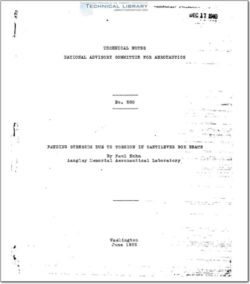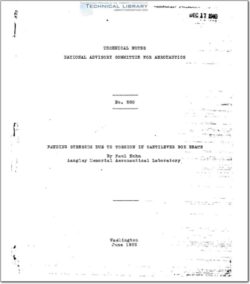naca-tn-530

- Version
- 166 Downloads
- 1.61 MB File Size
- 1 File Count
- April 23, 2016 Create Date
- April 23, 2016 Last Updated
National Advisory Committee for Aeronautics, Technical Notes - Pending Stresses Due to Torsion in Cantilever Box Beams

The paper beg ins with a brief discussion on the ori—
gin of the bending stresses in cantilever box beams under
torsion. A critical survey of existing theory is followed
by a summary of design formulas; this summary is based on
the most complete solution published but omits all refine~
ments considered unnecessary at the present state of den
velopment. Strain—gage tests made by the N.A.C.A. to ob-
tain some experimental verification of the formulas are
described next. Finally, the formulas are applied to a
series of box beams previously static-tested by the U.S.
Army Air Corps; the results show that the bending stresses
due to torsion are responsible to a large extent for the
free-edge type of failure frequently experienced in these
tests.
The problem of designing a box beam in torsion is
common in aircraft construction. If all cross sections
of the beam are free to warp out of their plane, the walls
will be in pure shear, which can be easily calculated.
If, however, the cross sections are partly or completely
restrained from Warping, which is the case if any varia~
tion of cross section or of loading occurs along the span,
then bending stresses will arise in addition to the shear
stresses.
These bending stresses may be very large at the root
of a cantilever box attached to a rigid support since
direct bending stresses usually exist also, the calcu-
lation of bending stresses due to torsion is important.
The theoretical analysis of this problem has been made
fairly recently, and it is the purpose of this paper to
give a critical survey of existing literature and a summa-
ry of design formulas. The reliability of these formulas
was checked by some strain-gage tests, which are described
and discussed. Finally, the paper shows the results of
applying the formulas to a series of duralumin box beams
that had been static-tested at Wright Field by the U.S.
Army Air Corps.
| File | Action |
|---|---|
| naca-tn-530 Pending Stresses Due to Torsion in Cantilever Box Beams.pdf | Download |
Comment On This Post